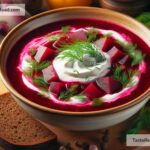How to Prepare a Traditional Russian Blini
Russian cuisine is rich in comforting and delicious dishes, but one of the most beloved is the blini. Blinis are thin, pancake-like creations that have been a staple of Russian households for centuries. They can be eaten sweet or savory, making them versatile and perfect for breakfast, lunch, or even dinner. Preparing traditional Russian blini is not complicated, and with a few simple ingredients, you’ll be able to make this iconic dish in your own kitchen.
What Are Blinis?
Blinis are similar to crepes, but they are uniquely Russian. Traditionally, blinis are made using yeast, which gives them a light and fluffy texture. Modern recipes often skip the yeast, making them faster to prepare. These thin pancakes are typically served with toppings like sour cream, jam, honey, butter, or caviar, depending on the occasion or preference.
In Russia, blinis are a big part of cultural celebrations. The most famous is Maslenitsa, or Pancake Week, a holiday marking the end of winter. During Maslenitsa, families make stacks of blinis and enjoy them together with various toppings.
Now, let’s get started on how to make your own traditional Russian blinis at home!
Ingredients You’ll Need
For a basic blini recipe, you only need simple ingredients you probably already have in your kitchen:
- 2 cups of all-purpose flour
- 3 cups of milk (warm, not too hot)
- 2 large eggs
- 1 tablespoon of sugar
- ½ teaspoon of salt
- 2 tablespoons of vegetable oil (plus extra for frying)
- Optional: 1 teaspoon of baking powder (if not using yeast)
If you want to make yeast-based blinis, you’ll need:
– 1 teaspoon of dry yeast
– 1 extra cup of warm milk
Step-by-Step Instructions
1. Prepare the Batter
Start by mixing the dry ingredients—flour, sugar, salt, and baking powder (if not using yeast)—in a large mixing bowl.
If you’re using yeast, dissolve it in warm milk first. Let it sit for 5–10 minutes until bubbles form, showing the yeast is active. Then, add the yeast mixture to the dry ingredients.
In a separate bowl, whisk together the eggs, warm milk, and vegetable oil. Slowly pour this liquid mixture into the dry ingredients, stirring gently until you get a smooth, lump-free batter. The batter should be thin enough to spread easily in a pan but not watery.
If you have time, let the batter rest for 20–30 minutes. This step helps the ingredients blend together and ensures lighter, fluffier blinis.
2. Heat the Pan
Select a non-stick or cast-iron frying pan and place it over medium heat. Add a small amount of oil or butter to grease the pan. Traditional Russian cooks often use a piece of paper or a brush to spread the oil evenly.
3. Cook the Blinis
When your pan is hot, ladle a small amount of batter into the center of the pan. Quickly tilt and swirl the pan to spread the batter in a thin, even layer. This technique will create the delicate, thin shape that blinis are known for.
Cook the blini for about 1–2 minutes, or until the edges start to lift and the bottom is golden brown. Flip the blini carefully using a spatula and cook for another 30 seconds to 1 minute on the other side. Transfer the cooked blini to a plate and cover it with a clean towel to keep it warm while you cook the rest.
Repeat the process with the remaining batter. You should end up with a stack of golden, round blinis ready to serve!
Toppings and Fillings
Blinis are best enjoyed with delicious toppings or fillings. Here are some classic ways Russians eat their blinis:
- Sweet Options:
- Jam (strawberry, raspberry, or apricot are popular choices)
- Honey
- Sweetened condensed milk
-
Fresh fruit and whipped cream
-
Savory Options:
- Sour cream
- Smoked salmon
- Caviar
- Diced cooked meat or mushrooms
For a special treat, you can spread warm butter over the blini before adding your topping of choice.
Tips for Perfect Blinis
- Don’t Overmix the Batter: Stir the batter until just combined. Overmixing can make your blinis tough.
- Use the Right Pan: A non-stick or cast-iron pan works best to prevent sticking.
- Adjust Heat as Needed: If your blinis cook too quickly or begin to burn, lower the heat slightly.
- Practice Makes Perfect: The first few blinis may not turn out perfect, but once you find the right batter consistency and cooking technique, you’ll be making them like a pro!
Conclusion
Traditional Russian blinis are easy to make and can be customized to suit your taste. Whether you’re celebrating a special occasion like Maslenitsa or simply want to enjoy a hearty breakfast, blinis are sure to impress.
Try making a batch of blinis today—you’ll love their soft, delicate texture and how well they pair with both sweet and savory toppings. Enjoy your homemade Russian blinis and share them with family and friends to bring a bit of Russian tradition to your table!


